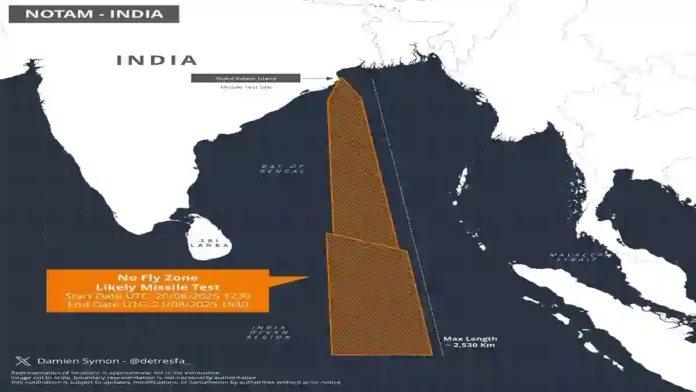India’s recent announcement of an expanded danger zone for its upcoming missile trial in the Indian Ocean—now stretching to approximately 2,530km—signals a major step in its advancing strategic missile capability and national defence program.
The Notice To Airmen (NOTAM), issued for the test period of August 20–21, 2025, originates from launch sites along the Odisha coast, including the critical strategic facilities at Balasore and Dr. APJ Abdul Kalam Island. This revised notification, disclosed on August 12, represents a notable increase from earlier test zones and demonstrates the government’s heightened commitment to safety for aviation and maritime traffic during these trials.
Read- DRDO: A Peek Into India’s Expanding Missile Arsenal
Defence experts are closely watching this development, speculating that India may be preparing for a full-scale trial of either an advanced intercontinental ballistic missile (ICBM)—potentially the Agni-6—or a new hypersonic missile variant.
This inference stems from the unprecedented range covered by the danger zone, which outpaces previous missile tests, including recently proven systems such as Agni-V whose range already exceeds 5,000km.
The test zone’s vast reach into the Indian Ocean also supports the notion that India is validating capabilities designed to target distant strategic assets and reinforce its second-strike, long-range deterrence posture.
Read- IAF Seeks 114 Rafale Jets In Direct Deal With France, Bypassing MRFA Tender
India’s missile development, spearheaded by the Defence Research and Development Organisation (DRDO), reflects a dual emphasis on technological innovation and self-reliance under the ‘Atmanirbhar Bharat’ initiative.
The country continues to invest in expanding its ballistic missile arsenal and Ballistic Missile Defence (BMD) systems, aiming to achieve a fully indigenous arsenal that can reliably respond to evolving regional threats. Within the last year, India conducted successful tests and operational launches of both ballistic and hypersonic missiles from the Odisha test range, underscoring its rapid progress in indigenous missile technologies and command structures.
Read- DRDO Developing Jet-Powered Variant of SAAW Glide Bombs
The significance of the 2025 missile test is amplified in the context of rapidly evolving strategic dynamics across Asia. India faces an intensifying security environment as China and Pakistan continue to upgrade their missile delivery systems, nuclear arsenals, and associated strategic infrastructure.
By extending missile test ranges, pursuing MIRV (Multiple Independently targetable Re-Entry Vehicles) capability, and upgrading guidance and propulsion technologies, India intends to maintain credible deterrence and operational flexibility across the wider Indo-Pacific—thereby enhancing its ability to conduct long-range, precise retaliatory strikes if needed.
The upcoming launch is more than a simple weapons trial—it is a demonstration of advanced engineering, doctrine refinement, and geopolitical signaling. Should the event confirm the capability of a new missile such as Agni-6 or an indigenous hypersonic variant, India would further consolidate its status as a major missile power. These advancements reduce strategic reliance on foreign technology, bolster national security, and enable India to maintain a stable power equilibrium in the region.
India’s expanded missile test zone for August 2025 indicates an imminent evaluation of a potentially game-changing missile system, reflecting the nation’s steady ascent in defence technology and strategic autonomy. The test is closely aligned with broader national ambitions for self-sufficiency in defence, operational flexibility, and robust deterrence against regional adversaries, confirming India’s growing stature as a decisive security actor amid Asia’s shifting strategic landscape.
IDN (With Agency Inputs)
Agency




